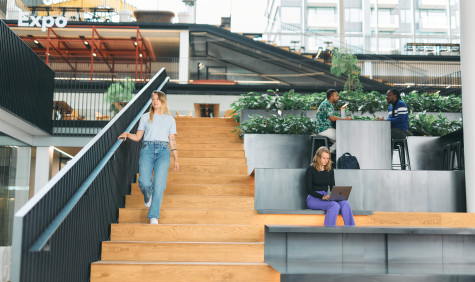Discover the future of the campus: 14 innovative examples that inspire
Download the publication (in Dutch).
The publication marks the conclusion of the second research project on Future Campus, in which we are exploring what the campus of the future looks like within SURF.
Tools for campus renewal
A campus is more than a collection of buildings on the grounds of an educational or research institution. It is a dynamic environment where students, teachers, researchers and businesses come together to learn, experiment and innovate. Societal developments such as digitisation, new forms of education and changing student needs call for flexible and innovative campuses, but how do you tackle this successfully?
To answer this question, we analysed the success factors of fourteen existing campus innovations in 2024, such as immersive rooms, flexibly configurable classrooms and hybrid learning environments that improve student-teacher interaction. The results of the study provide inspiration and tools for institutions looking to revamp their campuses.
Success factors of existing innovations
One of the conclusions of the study is that the success of campus innovation and development does not depend on the size of the budget, but on the smart use of available resources and the strength of people involved. Important factors involved are:
- Board-level support
- A multidisciplinary team
- Room to experiment
- Involvement of users
Gerrie van Staalduinen, Future Campus project leader, explains: "Support from the board provides the necessary resources and protection from unnecessary rules. It also helps if team members complement each other and are given room within the institution to experiment. By tackling this flexibly and making adjustments where necessary, the project can grow step by step into an innovation that has real impact."
According to Gerrie, however, it starts with an engaged team of enthusiasts who start experimenting within existing processes. "It also helps if users of the campus, such as students, teachers and even external partners, are involved in the development."
Follow-up Future Campus
To gain more insight into the challenges faced by educational institutions, next year we will use pilots to investigate what approach institutions take to campus development and what effect this has on infrastructure and facilities. "Campus development is quite complex," explains Gerrie van Staalduinen. "You have to take into account all kinds of factors, such as budget cuts, complicated regulations and all kinds of users with different interests. Through the Future Campus project, we give institutions insight and tools to get to grips with this in a practical way."
With the results of the upcoming pilots, we can improve our SURF services and support institutions in setting up a future-ready campus. "But we cannot do that alone," says Gerrie. "That's why we work together with educational institutions to continuously innovate." Would you like to join this collaboration from your institution? Then contact Gerrie van Staalduinen.
Getting started with campus innovation?
Download the publication 'Future Campus - research into 14 Dutch campus innovations' (in Dutch) go to the Future Campus website or visit the Learning Spaces community for more information.
